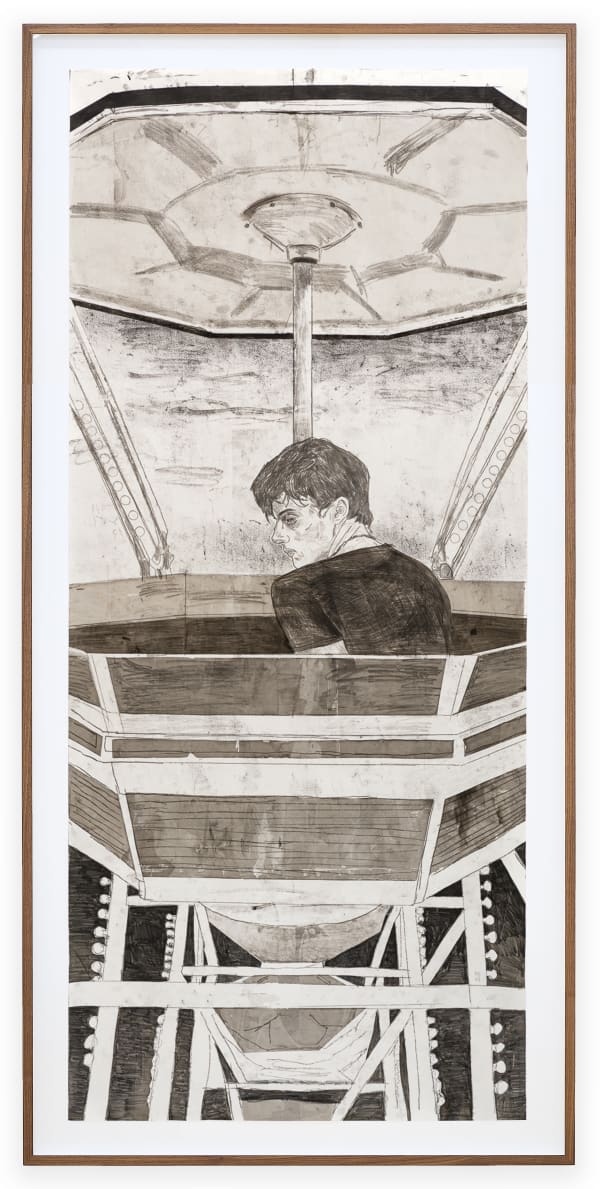-
In his fifth solo exhibition at Galerie Peter Kilchmann, US-American artist Hernan Bas (*1978, lives and works in Miami) presents a new group of paintings and works on paper, characterized by their fascinating mixture of emotional-melancholic depth, aesthetic beauty and social reflection. Also on view, is the installation A Little Romeo and Juliet in All of Us (2004/24), one of his earliest installations. Bas has established himself as one of the most prominent contemporary artists in the field of painting over the last two decades. His work can be seen in renowned museums and galleries worldwide, including the Museum of Modern Art in New York and the Rubell Family Collection. His works, often characterized by a vibrant color palette, distinct symbolism, narrative elements, personal mythology and art historical references, reflect on the complexity of identity and sexuality and question normative notions of gender and desire.
-
-
 Hernan Bas, Math makes Matthew melancholy, 2024
Hernan Bas, Math makes Matthew melancholy, 2024 -
 Hernan Bas, Melancholy (a pacifist in a bumper car), 2024
Hernan Bas, Melancholy (a pacifist in a bumper car), 2024 -
 Hernan Bas, Melancholy (merry-go-round), 2024
Hernan Bas, Melancholy (merry-go-round), 2024 -
 Hernan Bas, Melancholy (the broken pole-vaulter), 2024
Hernan Bas, Melancholy (the broken pole-vaulter), 2024 -
 Hernan Bas, Melancholy (the prized sun), 2024
Hernan Bas, Melancholy (the prized sun), 2024 -
 Hernan Bas, Melancholy (three scarecrows), 2024
Hernan Bas, Melancholy (three scarecrows), 2024
-
-
-
The rebellion against uniformity inherent in Bas’ work is reflected in the transhistorical theme of the “Gothic”. This artistic form of expression, which emerged in England in the late 18th century, was shaped by the uprisings of June 1780. Led by the anti-Catholic Lord George Gordon, people protested legal reforms that gave Catholics similar freedoms to the Anglican Church. These riots, characterized by religious fanaticism, stood in contrast to the prevailing rule of “reason”. The outbreak of violence, also interpreted as a sign of fear, can be found in the literature and art of the time, which often dealt with themes such as “order and disorder” and “enlightenment and apocalypse”. The painting of the Gothic movement at the end of the 18th century in England, often described as “black romanticism”, is characterized by themes that take up the human psyche, its fears and nightmares, giving space to the inexplicable, the eerie and the supernatural.
-
 The transience of life is also of central importance in the work Last caress (2024), which shows an androgynous young man in a striped sweater being embraced by a skeleton. While the historical Dance Macabre often show the reluctance of those people who are given their last escort by death, the Bas’ young man seems defiantly ignorant of the end of his own life. This introverted, withdrawn attitude is characteristic of the figures in Bas’ oeuvre: his pictures show androgynous young men who appear in his paintings pensive and reflective. They seem removed from reality and rarely interact directly with the viewer. Even if they have a peculiar vitality, this is not directly transferred to the viewer. Instead, they are captivated by the details of the works and their symbolism and invited to lose themselves in the depths of the paintings.
The transience of life is also of central importance in the work Last caress (2024), which shows an androgynous young man in a striped sweater being embraced by a skeleton. While the historical Dance Macabre often show the reluctance of those people who are given their last escort by death, the Bas’ young man seems defiantly ignorant of the end of his own life. This introverted, withdrawn attitude is characteristic of the figures in Bas’ oeuvre: his pictures show androgynous young men who appear in his paintings pensive and reflective. They seem removed from reality and rarely interact directly with the viewer. Even if they have a peculiar vitality, this is not directly transferred to the viewer. Instead, they are captivated by the details of the works and their symbolism and invited to lose themselves in the depths of the paintings. -
These dreaming or introverted figures have a mysterious, almost mystical aura reminiscent of the Gothic masters. The fact that they are removed from the world and seem to move in the depths of their subconscious is further emphasized by their isolation in the atmospheric interior spaces in which they find themselves. However, the homely is not synonymous with a feeling of homely security. In Melancholy (curling up) and Melancholy (the bad review) (both 2024), the titles also refer to the heaviness of the domestic scenes, which trigger an unspecified sense of unease. The uncanny aspect of these paintings is reminiscent of Sigmund Freud’s pair of opposites, the “Heimliche” (“homely/secretive”) and the “Unheimliche” (“uncanny”), which he presents in his seminal essay The Uncanny (1919). In the history of the word, the “Heimlich” is initially identified with the “Heimeligen”, the homely as the familiar, the comfortable, and only gradually shifts into the meaning of the hidden, the repressed, the secret. In this nuance, it can coincide with the uncanny. Freud concludes from the close connection between the opposite words: “If heimlich is everything that is hidden and repressed, then unheimlich (uncanny) is everything that should remain a secret, hidden and has emerged.” In this way, the cramped interiors of Bas’ paintings turn the home into a place of haunting by fear, but also into its co-player and resonance space. The relationship between inside and outside – both in an architectural sense and as part of the construction of the subject – is a constant in the inventory of manifestations of the uncanny. The uncanny always arises in the process of alienation from the gradual or sudden transformation of the familiar into the unfamiliar. The home turns against the self and turns out to be a claustrophobic constriction.
-
-
Bas’ paintings, however, go far beyond formal similarities with an art history of the Gothic. At a time when questions of identity and belonging are becoming ever more pressing, Bas uses the symbolism of the Gothic to illuminate contemporary issues. His works invite us to reflect on our own identity and explore the complexity of human relationships, and so Hernan Bas’ relationship with the art history of the “Gothic” is not only a tribute to the past, but also a call to reflect on the present. In a world often characterized by superficiality, Bas’ paintings can be read as an invitation to reflect on the depth of human emotion and experience.
-
-

Hernan Bas
A Little Romeo and Juliet in all of Us, 2004, revised in 2024With A Little Romeo and Juliet in All of Us (2004/24), this examination is translated from the canvas into the exhibition space. A series of objects are laid out like props for a play, reminiscent of the “scatter art” from the early 1990s. Together with the frottages of gravestones hung on the walls, they create a stage situation which, unlike the Bas paintings, is free of the human figure. The dreamlike, almost surreal scenery refers to the viewers as protagonists who are involved in questions of love, kinship, death, desire and loyalty. With the use of allegorical objects, figures and fantastical settings, Bas creates a visual language that is both intimate and universal. His works invite viewers to immerse themselves in a multi-layered world where the unreal merges with the everyday. Hernan Bas’ artistic practice is an example of the fusion of tradition and contemporary practice that raises both aesthetic and social questions. His art invites us to think beyond the boundaries of the visible and the familiar and to explore the complex narratives hidden in his evocative images.Text by Dr. Raphael Gygax -

Galerie Peter Kilchmann
Zahnradstrasse 21, Zürich
, 26 October - 20 December 2024Be the first to know updates about Galerie Peter Kilchmann
* denotes required fields
We will process the personal data you have supplied to communicate with you in accordance with our Privacy Policy. You can unsubscribe or change your preferences at any time by clicking the link in our emails.






















